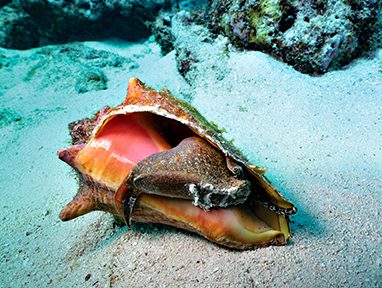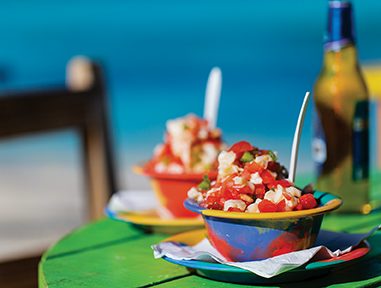What happened to the queen conch?
AN EDIBLE, SLOW-MOVING ANIMAL that lives in clear, shallow waters doesn’t have a high chance of survival these days. Conchs, specifically queen conchs, used to be widespread throughout the Florida Keys and the Caribbean. While the queen still reigns as a powerful symbol of these locations, this snail’s populations are decreasing to concerning levels.
Despite the presence of fishing regulations throughout most of the conchs’ range, numbers of queen conchs are now so low that in September 2022 the National Oceanic and Atmospheric Administration (NOAA) proposed that it be listed as a threatened species under the Endangered Species Act.
What happened to her former majesty? And what can be done to bring her back?
Life Cycle
With a lifespan of 40 years and late reproductive maturity (between years four and five), queen conchs are especially susceptible to overfishing. They grow to be approximately 12 inches long until they start to become capable of reproduction, and then they continue to grow in thickness. Generally, a queen conch with a thick, flared shell signifies a sexually mature adult, but the only reliable method of determining maturity is examination of the gonads.
Males and females need to be in physical contact with each other to reproduce, and the conch’s average movement of only a few meters per day contributes to their low population density. NOAA research indicates that 69 percent of Caribbean countries have conch populations below the minimum adult density required to support mating, which is 100 conchs per hectare.
Females lay an egg mass that can contain up to a half a million eggs, but only one in 8 million eggs will survive to maturity. Once fertilized, eggs hatch into free-swimming larvae that currents disperse. After one to three weeks they burrow into the sand in a nursery habitat such as shallow seagrass beds, where they stay for a year before emerging as juvenile conchs. Maturing adults then migrate to deeper coarse sand and rubble habitats.
Breeding season for queen conchs varies in length throughout the region but occurs between March and October, with peak reproduction occurring during the warmest water temperatures. After mating, the conchs return to their feeding grounds.


Fisheries
As an easy target, queen conchs have been exploited for thousands of years. Despite the conch’s attempts at concealing its iconic pretty pinkish hue on the inside of its shell with a brownish outer shell often covered in algae, they are fairly easy to spot on the ocean floor in the clear tropical waters where they reside.
They are also easy to catch. While some fishers use long, hooked poles to retrieve the conchs, most simply collect them by hand. Conchs are slow movers and live in shallow waters rarely deeper than 100 feet, so they are accessible to recreational divers.
Demand for conchs is high. Their uses have varied throughout the years and region. In Florida, conchs were originally harvested as curios, but in 1965 law mandated that fishers must use the meat along with the shell. Throughout the Caribbean, conchs have always been a food staple, with the meat being cooked in stews, fried as fritters or cracked conch, added to chowder, and served fresh as ceviche or salad. Shells have been used for tools, instruments, jewelry, building material, and décor.
Queen conchs are one of the most important fishery resource species in the Caribbean, second only to the spiny lobster. The conch fishery supports approximately 20,000 fishers, most of whom come from families of conch fishers. As conch populations decrease, fishers have to travel farther from home and dive deeper to get their catch, increasing their expenses and safety risk.
With fewer conchs available, poaching has increased and more catch are not meeting size restrictions. A recent study spanning two decades in the Bahamas showed that the size of conch shells fishers discarded in areas of high fishing pressure were below the legal size allowed for harvest. These results signify that fewer legal-size conchs are available for the fishers to take.
Regulations
Various management tactics were implemented when conch populations started showing signs of stress from overfishing in the 1970s, but they vary widely in the more than 30 countries that provide some protection to conchs. In general, management strategies include size restrictions, closed seasons, protected areas, harvest quotas, and gear restrictions (for example, scuba diving is not permitted in some countries).
South Florida has the strictest management levels; commercial fisheries of queen conch closed in Florida in 1976, and recreational fisheries closed in 1986. In 1992 the Convention on International Trade in Endangered Species of Wild Fauna and Flora (CITES) listed queen conch in its Appendix II, indicating that international trade could threaten the species if not controlled. Under the CITES treaty, exporting conch meat or shells requires a permit.
Despite these efforts, queen conch populations have continued to decline. Some management strategies are ineffective because they are based on outdated, limited, or incorrect information about the conch life cycle. Using shell length in size restrictions, for example, is not effective; lip thickness is a better indicator of sexual maturity.
Many Caribbean countries use closed seasons, but their timing does not always align well with the conch life cycle. Lobster season, for example, determines the closed conch season in Jamaica to allow for two distinct seasons with little overlap so fishers can have access to resources year-round. And some governments established protected areas based on user preference instead of explicitly restricting access to conchs’ nursery or breeding grounds.
Regulations are effective only with compliance and enforcement. Illegal and unreported harvest is a continued issue throughout the various regions. In 2014 NOAA’s National Marine Fisheries Service declined listing queen conch under the Endangered Species Act, but they are now reviewing its status again and should make a final decision by September 2023. The economic impacts of listing queen conchs as a threatened species could hurt Caribbean nations that regularly export conch.
Habitat Quality
Each life stage of queen conchs — larval, juvenile, and adult — has specific habitat requirements, and their quality is important for survival. Human activities such as dredging and runoff negatively affect conch reproduction.
In the late 1990s and early 2000s scientists found that conchs in nearshore Florida Keys waters were physically incapable of reproduction because their gonads never fully developed, but offshore populations reproduced as expected. When they collected conchs from nearshore waters and placed them offshore, the conchs began reproducing normally within months. Conversely, offshore conchs moved to nearshore waters quickly lost their reproductive ability. Zinc, copper, or even mosquito-control pesticides present in the nearshore waters are among the likely culprits.
Why Do We Care?
Queen conchs are an important ecological component of the Caribbean marine ecosystem. As herbivores, queen conchs eat detritus, diatoms, and algae. Conchs are prey for animals that have their own niche, including nurse sharks, octopus, horse conchs, porcupinefish, sea turtles, and crabs. The loss of queen conchs will affect the entire food web.
Queen conchs are also important culturally. The Florida Keys are the self-proclaimed Conch Republic. In the Caribbean, conchs have been an important food source for thousands of years, and the shells serve a huge array of purposes. The conch fishery is a livelihood for thousands of people, and conch fishing has been a tradition among some families for generations.
A queen conch is on the coat of arms and national flag of the Turks and Caicos and on the coat of arms of the Bahamas. In the Virgin Islands, the conch shell symbolizes freedom and resistance to slavery. Many cultures have used conch shells for communication, in rituals, and as a musical instrument.
What Can We Do?
Governments can readdress management strategies and ensure restrictions are based on current scientific information. Improving water quality and protecting conch habitats are also important.
Conch populations are not recovering on their own, so creative tactics likely are necessary. Scientists have perfected aquaculture techniques to rear conchs in a hatchery, but raising conchs in a lab and releasing them in the wild is often costly. A new conch hatchery, however, hopes to improve outcomes while enhancing economic opportunities for local fishers.
Supported in part by grants from NOAA Fisheries, the U.S. Department of Agriculture’s Agricultural Research Service, and Puerto Rico Sea Grant, the Naguabo Queen Conch Hatchery in Puerto Rico is a collaborative project by Florida Atlantic University, Conservación ConCiencia, and the Naguabo Fishing Association. The hatchery provides income for conch fishers who bring in eggs from known conch nursery habitats in the wild. The fishers also assist with installation of the facilities and day-to-day work at the hatchery. The benefits of such collaborations span beyond simply adding to the wild stock.
No clear answer exists for how to best ensure the queen reigns, but many people — including fishers, scientists, and divers — feel passionate about this snail’s importance. While survival of the queen conch is up against many odds, its tale is not over yet. AD
© Alert Diver — Q2 2023